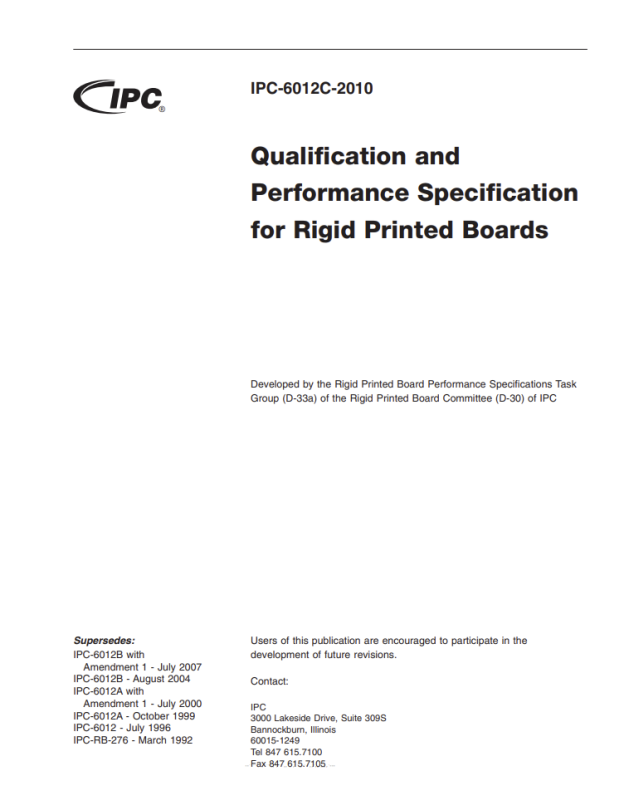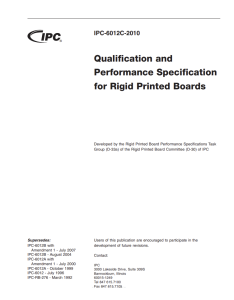 Well-known PCB supplier
Well-known PCB supplier
+86 13603063656

In the electronics manufacturing world, standardization is not a luxury—it’s a necessity. Among the many global standards governing PCB (Printed Circuit Board) production and inspection, two stand out as cornerstones for rigid board quality and acceptability: IPC-6012 and IPC-A-600. This article offers a comprehensive guide to both, from their background and key differences to practical applications and industry value. Whether you’re a process engineer, quality manager, or sourcing specialist, understanding these two standards will significantly enhance your decision-making and production outcomes.

IPC6012, IPC-6012
The IPC (Institute for Interconnecting and Packaging Electronic Circuits) was founded in 1957 by six U.S.-based PCB suppliers. It emerged as a response to widespread quality inconsistencies and compatibility issues in the early circuit board industry. Over the decades, IPC has evolved into a leading global standardization body, issuing guidelines across the entire electronics value chain—including PCB design, manufacturing, assembly, and testing.
The organization’s mission is simple yet powerful: to reduce communication barriers, enhance production consistency, and accelerate the adoption of new technologies like HDI and flexible PCBs. Its influence spans across North America, Europe, and Asia, impacting billions of electronic products annually.
2.1 Scope and Applicability IPC-6012, formally titled “Qualification and Performance Specification for Rigid Printed Boards,” defines quality and performance benchmarks for a wide range of rigid PCBs:
2.2 Core Structure: Performance Classes and Metrics At the heart of IPC-6012 is the classification system:
| Class | Application Example | Requirements Summary |
|---|---|---|
| 1 | Consumer devices (e.g., toys, remotes) | Permits cosmetic defects; minimal performance bar |
| 2 | Commercial electronics (e.g., PCs) | Function-critical defect-free; moderate cosmetics |
| 3 | Mission-critical (e.g., aerospace) | Zero tolerance for functional or visual defects |
It covers drilling tolerances, plating thickness, electrical testing protocols, thermal stress resistance, and more. For example, a Class 3 board must meet tighter trace width accuracy (±0.05mm) and insulation resistance (≥100MΩ).
3.1 Purpose and Value IPC-A-600 complements IPC-6012 by providing a visual inspection benchmark. It translates the performance requirements into photo-guided acceptability criteria for both internal and external board features. This ensures visual inspection staff can uniformly identify issues.
3.2 Three-Level Visual Classification The standard uses three image categories:
This visual context bridges the interpretation gap and eliminates subjectivity, especially in global supply chains. A classic use case? Identifying via cracks, solder mask voids, or copper delamination.
| Aspect | IPC-6012 | IPC-A-600 |
| Purpose | Defines how PCBs should be manufactured | Defines how finished PCBs should be judged |
| Focus | Technical specifications and test methods | Visual acceptance criteria |
| Use Phase | Design, production control | Final inspection, supplier auditing |
They work hand in hand: IPC-6012 ensures quality is built into the board, while IPC-A-600 ensures it’s consistently evaluated after production.
In real-world PCB production, relying on just one standard leads to blind spots. For example, manufacturers who only follow IPC-6012 might miss customer rejections caused by cosmetic concerns. On the flip side, inspecting per IPC A-600 without understanding Class 2 or 3 requirements could result in false rejections or missed critical issues.
Data proves the synergy: According to the 2024 IPC Quality Report, manufacturers that implement both standards experience 42% fewer customer complaints and 35% lower rework rates.
One example of best practices in action is Jerico Multilayer PCB, a company with 14+ years of experience delivering high-reliability boards for medtech, telecom, and industrial automation. Jerico not only strictly follows IPC-6012 for Class 3 boards but also integrates IPC-A-600-based training for all quality inspectors. This dual-standard adherence has been key to their consistently low defect rates and strong customer retention.
With the rise of high-frequency RF circuits, ultra-thin flex boards, and embedded sensor arrays, both IPC-6012 and IPC-A-600 are evolving. The latest revision of IPC-6012 includes stricter impedance control and guidelines for advanced laminate materials. IPC-A-600 is also being expanded with high-res 3D imaging examples for newer defect types.
To stay ahead, PCB manufacturers must monitor updates and invest in regular training.
IPC 6012 and IPC A-600 represent the gold standard for PCB performance and inspection. Used together, they close the quality loop between design intent and delivered product. For PCB manufacturers, embracing both is not just a matter of compliance—it’s a pathway to consistent quality, fewer disputes, and enhanced brand credibility.
And for those seeking a trusted manufacturing partner, Jerico Multilayer PCB offers both compliance and competence—ensuring your boards meet the highest global standards from the inside out.
Q1: Is IPC-6012 mandatory for all PCB manufacturers? No, but it is widely adopted, especially by OEMs in aerospace, automotive, and medical industries. It ensures consistent performance and regulatory compliance.
Q2: What’s the main benefit of IPC A-600? It provides visual examples of acceptable vs. unacceptable PCB conditions, improving consistency in inspection and reducing subjective judgments.
Q3: Can a PCB meet IPC 6012 but fail IPC A-600? Yes, especially if cosmetic defects are present. That’s why both standards should be used together.
Q4: How do I know which class (1, 2, or 3) my board should meet? It depends on end-use. Consumer gadgets typically use Class 1, computers use Class 2, and life-critical devices use Class 3.
Q5: Does Jerico Multilayer PCB support Class 3 production? Absolutely. We specialize in Class 3 PCBs, backed by stringent internal controls and full compliance with both IPC-6012 and IPC-A-600.
Connect to a Jerico Multilayer PCB engineer to support your project!
Request A Quote